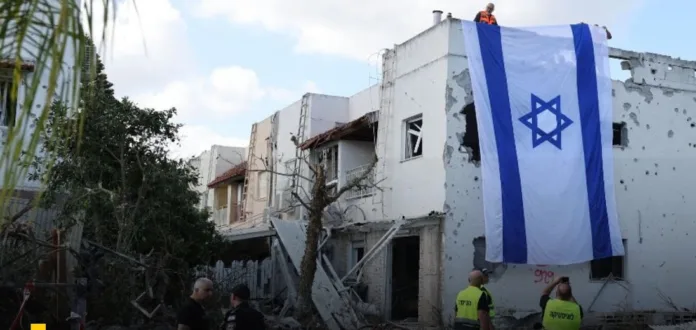Kiryat Bialik and neighbouring cities grapple with the aftermath of Hezbollah’s bombardments, highlighting the urgent need for public shelters.
Kiryat Bialik, a serene city in northern Israel, finds itself caught in the crossfire of escalating violence as Hezbollah launches rocket attacks from Lebanon. Known for its picturesque streets and close-knit community, Kiryat Bialik is part of the Krayot, a group of five cities located north of Haifa, including Kiryat Yam, Kiryat Ata, Kiryat Haim, and Kiryat Motzkin. Together, these cities house nearly 200,000 residents and have experienced significant development since their establishment in the 1930s and 1940s.
On September 22, 2024, Kiryat Bialik was struck by a Hezbollah rocket, resulting in injuries, property damage, and widespread fear. The aftermath was evident throughout the city, with burnt cars and buildings serving as stark reminders of the violence. Charred patterns marked windows, and shrapnel scars dotted the walls, painting a grim picture of the day’s events. Symbols of resilience emerged as the Israeli flag and the flag of Kiryat Bialik hung side by side over damaged structures, signifying unity in the face of adversity.
In response to the attack, the Israel Defense Forces (IDF) Home Front Command mobilized quickly, assessing the damage and assisting victims. Their presence was a reassurance for residents who have faced similar challenges before, particularly during the 2006 war with Hezbollah, when the absence of the Iron Dome left many vulnerable.
Despite the ongoing violence, the people of Kiryat Bialik display remarkable resilience. Local authorities and community members have grown accustomed to the reality of living under the threat of rocket fire, relying on established protocols and emergency systems to navigate this dangerous landscape. However, the city and its neighboring areas remain critically under-equipped in terms of public shelters. The absence of adequate fortified spaces poses a significant risk to residents, highlighting a pressing need for governmental action to ensure public safety.
As tensions continue to rise, the long-term implications for the Krayot and northern Israel become increasingly concerning. With Hezbollah launching over 8,000 rockets since the outbreak of conflict following the October 7 Hamas attack, the need for effective protective measures has never been more urgent. While evacuating communities provided temporary relief, the lack of permanent shelters necessitates a more sustainable solution to protect the residents who call this region home.
Amidst the chaos, life persists in Kiryat Bialik. On the day of the attack, many residents returned to their routines after the initial shock wore off. Fishermen cast their lines into the turbulent waters, surfers braved the waves, and commercial vessels continued their operations off the coast. The local spirit remains unbroken, much like the legacy of figures such as Haviva Reik, a resistance fighter whose bravery during World War II serves as a source of inspiration for the community today.
Analysis:
Political:
The ongoing conflict in northern Israel highlights the complex political dynamics at play. The Israeli government faces intense pressure to safeguard its citizens while managing international perceptions. The frequent rocket attacks from Hezbollah complicate the narrative, pushing the government to bolster its military response while simultaneously advocating for diplomatic solutions. The recent escalations may impact regional alliances, pushing Israel to reassess its strategies regarding both Hezbollah and its broader approach to peace in the region.
Social:
The social fabric of communities like Kiryat Bialik is severely tested during periods of conflict. Residents find themselves united by shared experiences, forging strong bonds as they navigate the challenges posed by rocket fire. This communal solidarity manifests in various ways, from shared resources to emotional support systems. However, the ongoing threat of violence also breeds anxiety, affecting mental health and overall community well-being. The necessity for public shelters reflects a growing awareness of the need for safety and stability in daily life.
Racial:
The situation in northern Israel underscores the multifaceted racial and ethnic dynamics in the region. Kiryat Bialik, like many cities in Israel, is home to diverse populations, including Jews from various backgrounds. The conflict often exacerbates existing tensions, as different groups may respond to threats differently. Addressing the needs of all communities affected by the violence becomes imperative for fostering long-term peace and coexistence.
Gender:
Gender dynamics play a crucial role in the response to conflict. Women and children often bear the brunt of the emotional and physical toll during times of war. As families seek safety in makeshift shelters, the burden of care frequently falls on women, who must manage household responsibilities amid chaos. Addressing these dynamics is essential in any response strategy, ensuring that the needs of vulnerable populations are met during crises.
Economic:
The economic impact of the conflict is significant, affecting businesses and livelihoods in the region. The ongoing violence deters investment and tourism, straining local economies already reeling from previous conflicts. The urgent need for public shelters also presents an economic challenge, requiring funds and resources that could be allocated elsewhere. Addressing the economic fallout necessitates a comprehensive approach, combining immediate support with long-term development strategies to stabilize the affected areas.
In summary, the situation in Kiryat Bialik and the broader Krayot area reflects the intersection of political, social, racial, gender, and economic factors amidst ongoing violence. The resilience of the community stands as a testament to their spirit, but the pressing need for public shelters and comprehensive support systems remains a critical issue that demands immediate attention.
